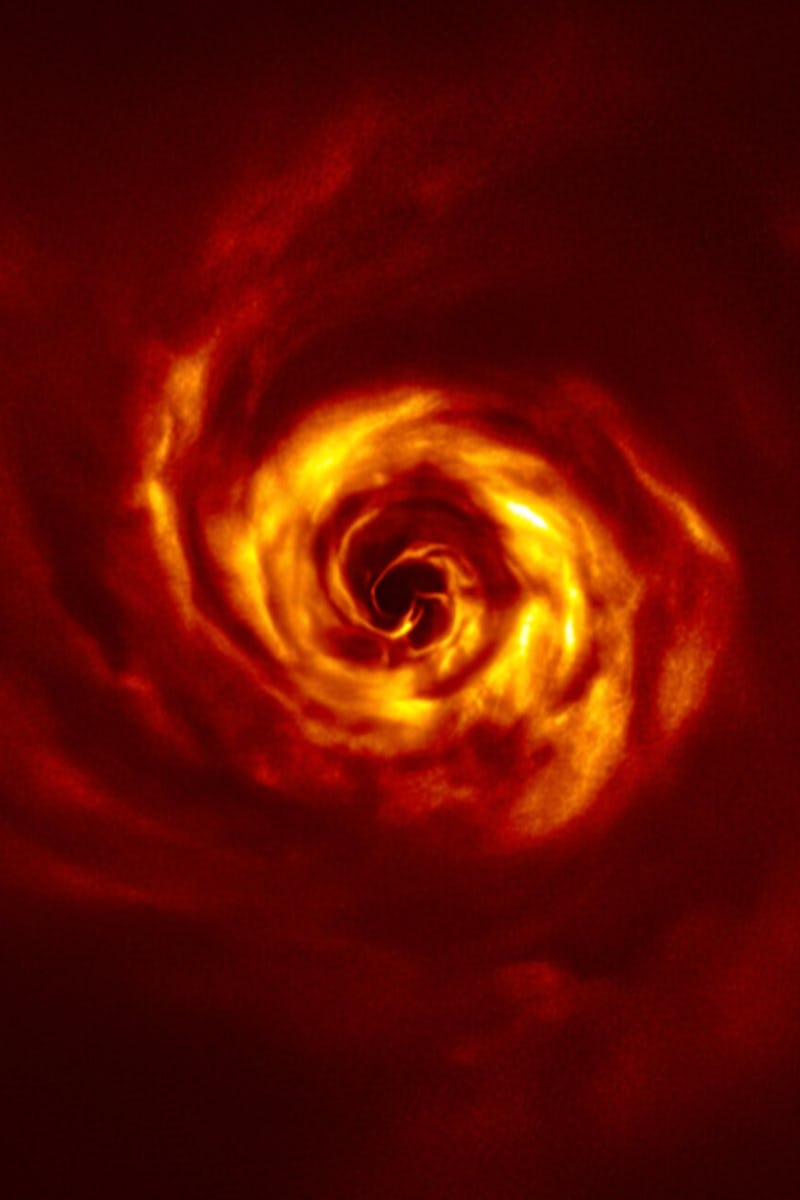
Images reveal the first glimpse of a baby planet being born
The European Southern Observatory captured a dense disc of dust and gas, revealing signs that a planet may be forming.
by Passant RabiePlanets form from a disk of gas and dust that encircle a young star — the dusk particles only 1/50th the diameter of a single human hair. Gravitational forces pull the gas and dust together and, sometime between 1 to 10 million years later, all of that collision results in a planetary body.
This process is known by scientists. What scientists haven't known is what the birth of a planet actually looks like.
Now, a recent observation by the European Southern Observatory's (ESO) Very Large Telescope (VLT) is theorized to be the first look at a baby planet as it coos its way into the vast universe.
The new observations are detailed in a study published Wednesday in the journal Astronomy & Astrophysics.
The team of scientists behind the new study began by observing a young star system, dubbed AB Aurigae. This system is located around 520 lightyears away from Earth in the constellation Auriga.
“We need to observe very young systems to really capture the moment when planets form,” lead author Anthony Boccaletti, a researcher at the Observatoire de Paris, PSL University in France, explains.
ESO captured these images of a young star system, with hints of planetary formation.
In the images captured by ESO's telescope, the star is surrounded by a dense disc of dust and gas.
A detail within this swirl is the key to this discovery: The slight twist in the swirling disc is a telltale sign of a baby planet being formed.
The bright yellow twist seen at the center of the image above is about as far from the star as the planet Neptune is from the Sun.
That slight twist indicates the spot where the cosmic infant is causing disturbances in the gas, kicking it in the form of waves, much like a human baby kicks from the inside of its mother's womb. As the planet rotates around its 'mommy' host star, these waves are shaped into the form of a spiral arm.
"The twist is expected from some theoretical models of planet formation,” co-author Anne Dutrey, a researcher at the Astrophysics Laboratory of Bordeaux in France, explains.
“It corresponds to the connection of two spirals — one winding inwards of the planet’s orbit, the other expanding outwards — which join at the planet location. They allow gas and dust from the disc to accrete onto the forming planet and make it grow."
Scientists first observed hints of this planetary birth a few years ago with Atacama Large Millimeter/submillimeter Array in northern Chile. This instrument revealed two spiral arms near the young star, within the inner region of its surrounding disk. However, scientists needed a clearer image of the star system in order to capture the disk in detail and know exactly what they were observing.
In late 2019 and early 2020, the team of astronomers conducted follow-up observations of AB Aurigae using VLT, providing the deepest images of the star system to date.
More than thousand of planets have been detected and observed in the vast universe. However, there is still so much unknown about how the planets came to be in the first place. The recent observations inches scientists one step closer to better understanding the formation of planetary bodies in our own Solar System, and beyond.
Abstract: Context. Planet formation is supposed to occur in the first million years of a planetary system through various processes, which remain to be tested by means of observations. Aims. With the recent discovery from ALMA of two gaseous spiral arms inside the ∼120 au cavity, connected to dusty spirals, the famous protoplanetary disk around AB Aurigae presents a strong interest to investigate the mechanisms leading to giant planet formation. A candidate protoplanet located inside a spiral arm has been claimed from the same ALMA data. Methods. We used SPHERE at the VLT to perform near-IR high contrast imaging of AB Aur in polarized and unpolarized light, in order to study the morphology of the disk and to search for signs of planet formation. Results. SPHERE delivered the deepest images ever obtained for AB Aur in scattered light. Among the many structures yet to be understood, we identified not only the inner spiral arms, but we also resolved a feature in the form of a twist in the eastern spiral at a separation of about 30 au. The twist of the spiral is perfectly reproduced with a planet-driven density wave model when projection effects are accounted for. We measured an azimuthal displacement with respect to the counterpart of this feature in the ALMA data, which is consistent with Keplerian motion on a 4-yr baseline. Another point source is detected near the edge of the inner ring, which is likely the result of scattering as opposed to the direct emission from a planet photosphere. We tentatively derived mass constraints for these two features. Conclusions. The twisted spiral pattern and its apparent orbital motion could well be the first direct evidence of a site of protoplanet formation.
This article was originally published on